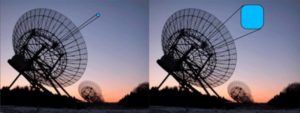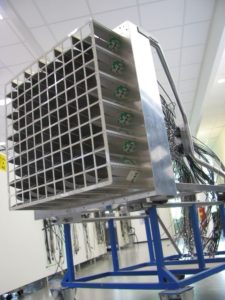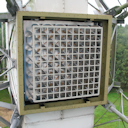What is Apertif?
The global radio astronomical community is working towards the Square Kilometre Array (SKA), a radio telescope a hundred times bigger and better than any current radio telescope. One of the major improvements that the SKA will bring is that the field of view, i.e. the region of the sky that can be imaged in a single observation, will be much larger than what is possible now.
There are several ways of doing this, and Apertif is a project that explores one of the technologies giving such a larger field of view, while also trying to exploit it for doing science. More concrete, Apertif aims to increase the field of view of the Westerbork Synthesis Radio Telescope (WSRT) with a factor 25, as is illustrated in the picture here.  This remarkable performance gain is achieved by placing a receiver array in the focus of each parabolic dish of the WSRT, instead of the single receiver element that the current system employs. Such an array in the focus of a dish is called a phased-array feed (PAF).
This remarkable performance gain is achieved by placing a receiver array in the focus of each parabolic dish of the WSRT, instead of the single receiver element that the current system employs. Such an array in the focus of a dish is called a phased-array feed (PAF).
The increase in field of view is comparable to the performance leap of optical telescope systems in the past when they made the transition from a single photometer in the telescope focus to large-format CCD detector arrays. Apart from studying the technology, because Apertif will be installed at an existing telescope, Apertif will make it possible to start doing some of the kinds of astronomy that SKA will do. So it is not only a technological project, but also, and mainly so, a science project.
 The image on the right shows one of the focal-plane array that have been installed in 12 of the telescopes. One can clearly see the many elements of the PAF (there are 121 in this PAF). Each element receives signals from the sky and the field of view of each element has the same size as the field of view of the WSRT. In other words, the current WSRT system is equivalent with using only one of these elements. However, each element looks in a slightly different direction and sees a slightly different part of the sky. This means that by combining the signals of all elements a larger part of the sky can be observed. With Apertif, the WSRT can image an area on the sky about 25 times the size of the full moon.
The image on the right shows one of the focal-plane array that have been installed in 12 of the telescopes. One can clearly see the many elements of the PAF (there are 121 in this PAF). Each element receives signals from the sky and the field of view of each element has the same size as the field of view of the WSRT. In other words, the current WSRT system is equivalent with using only one of these elements. However, each element looks in a slightly different direction and sees a slightly different part of the sky. This means that by combining the signals of all elements a larger part of the sky can be observed. With Apertif, the WSRT can image an area on the sky about 25 times the size of the full moon.
The telescope was operational for 2.5 years since July 2019 during which successfully recorded imaging and time-domain data available to the community for science exploitation (link to https://science.astron.nl/telescopes/wsrt-apertif/apertif-data-access/).
A more detailed description of Apertif can be found in the paper Van Cappellen et al.
